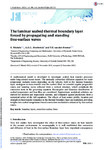The laminar seabed thermal boundary layer forced by propagating and standing free-surface waves
| dc.contributor.author | Michele, Simone | |
| dc.contributor.author | Borthwick, Alistair | |
| dc.contributor.author | van den Bremer, TS | |
| dc.date.accessioned | 2023-02-13T11:43:56Z | |
| dc.date.available | 2023-02-13T11:43:56Z | |
| dc.date.issued | 2023-02-10 | |
| dc.identifier.issn | 0022-1120 | |
| dc.identifier.issn | 1469-7645 | |
| dc.identifier.other | A11 | |
| dc.identifier.uri | http://hdl.handle.net/10026.1/20288 | |
| dc.description.abstract |
A mathematical model is developed to investigate seabed heat transfer processes under long-crested ocean waves. The unsteady convection–diffusion equation for water temperature includes terms depending on the velocity field in the laminar boundary layer, analogous to mass transfer near the seabed. Here we consider regular progressive waves and standing waves reflected from a vertical structure, which complicate the convective term in the governing equation. Rectangular and Gaussian distributions of seabed temperature and heat flux are considered. Approximate analytical solutions are derived for uniform and trapezoidal currents, and compared against predictions from a numerical solver of the full equations. The effects of heat source profile, location and strength on heat transfer dynamics in the thermal boundary layer are explained, providing insights into seabed temperature forced convection mechanisms enhanced by free-surface waves. | |
| dc.format.extent | a11- | |
| dc.language | en | |
| dc.language.iso | en | |
| dc.publisher | Cambridge University Press (CUP) | |
| dc.rights | Attribution 4.0 International | |
| dc.rights.uri | http://creativecommons.org/licenses/by/4.0/ | |
| dc.subject | boundary layers | |
| dc.subject | waves/free-surface flows | |
| dc.title | The laminar seabed thermal boundary layer forced by propagating and standing free-surface waves | |
| dc.type | journal-article | |
| dc.type | Journal Article | |
| plymouth.author-url | https://www.webofscience.com/api/gateway?GWVersion=2&SrcApp=PARTNER_APP&SrcAuth=LinksAMR&KeyUT=WOS:000923838200001&DestLinkType=FullRecord&DestApp=ALL_WOS&UsrCustomerID=11bb513d99f797142bcfeffcc58ea008 | |
| plymouth.volume | 956 | |
| plymouth.publication-status | Published | |
| plymouth.journal | Journal of Fluid Mechanics | |
| dc.identifier.doi | 10.1017/jfm.2023.21 | |
| plymouth.organisational-group | /Plymouth | |
| plymouth.organisational-group | /Plymouth/Faculty of Science and Engineering | |
| plymouth.organisational-group | /Plymouth/Faculty of Science and Engineering/School of Engineering, Computing and Mathematics | |
| plymouth.organisational-group | /Plymouth/REF 2021 Researchers by UoA | |
| plymouth.organisational-group | /Plymouth/REF 2021 Researchers by UoA/UoA12 Engineering | |
| plymouth.organisational-group | /Plymouth/Users by role | |
| plymouth.organisational-group | /Plymouth/Users by role/Academics | |
| dcterms.dateAccepted | 2022-12-22 | |
| dc.rights.embargodate | 2023-9-6 | |
| dc.identifier.eissn | 1469-7645 | |
| dc.rights.embargoperiod | Not known | |
| rioxxterms.versionofrecord | 10.1017/jfm.2023.21 | |
| rioxxterms.licenseref.uri | http://creativecommons.org/licenses/by/4.0/ | |
| rioxxterms.type | Journal Article/Review |



